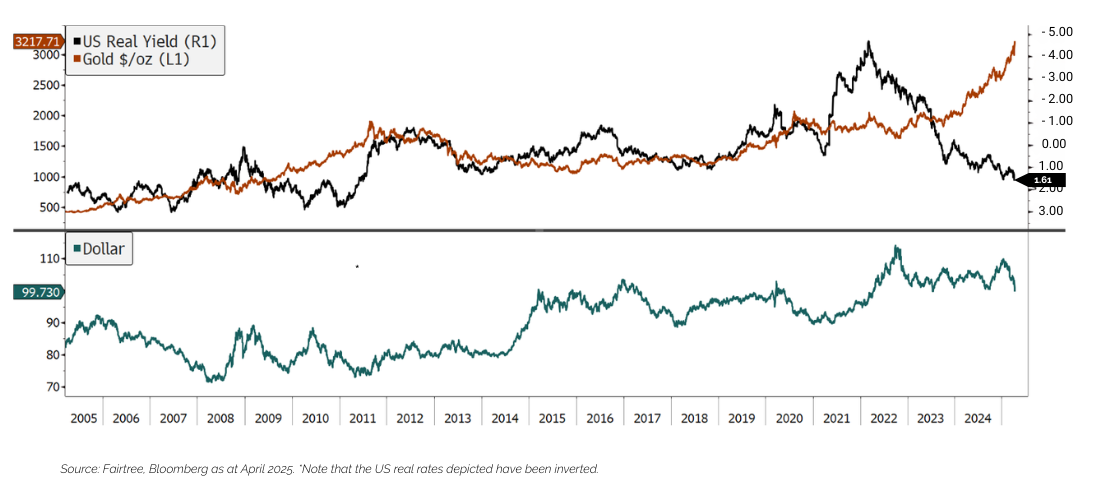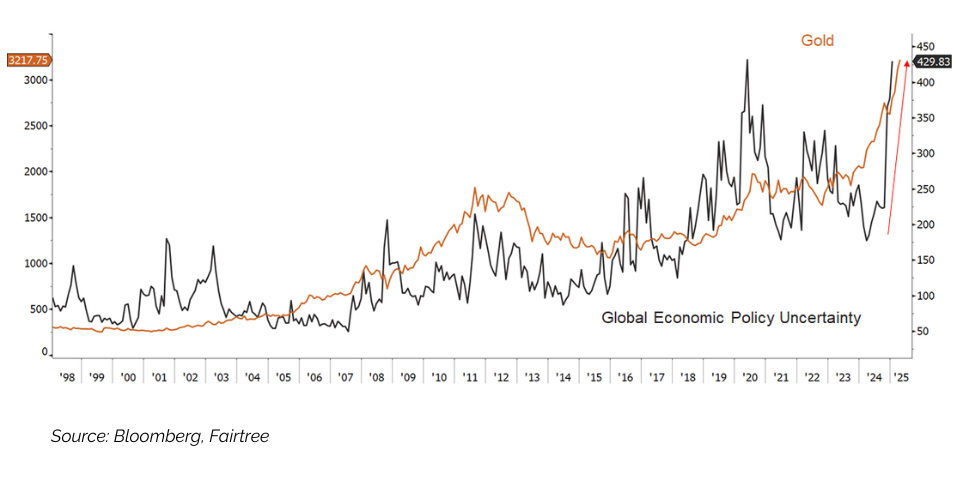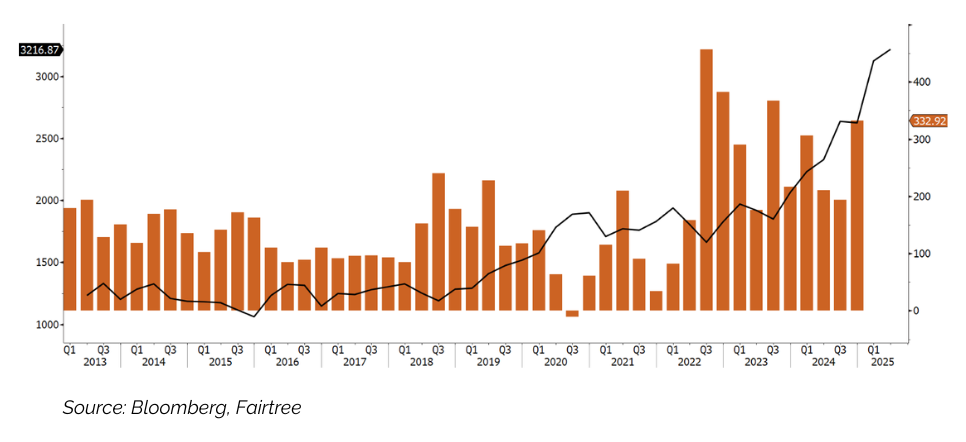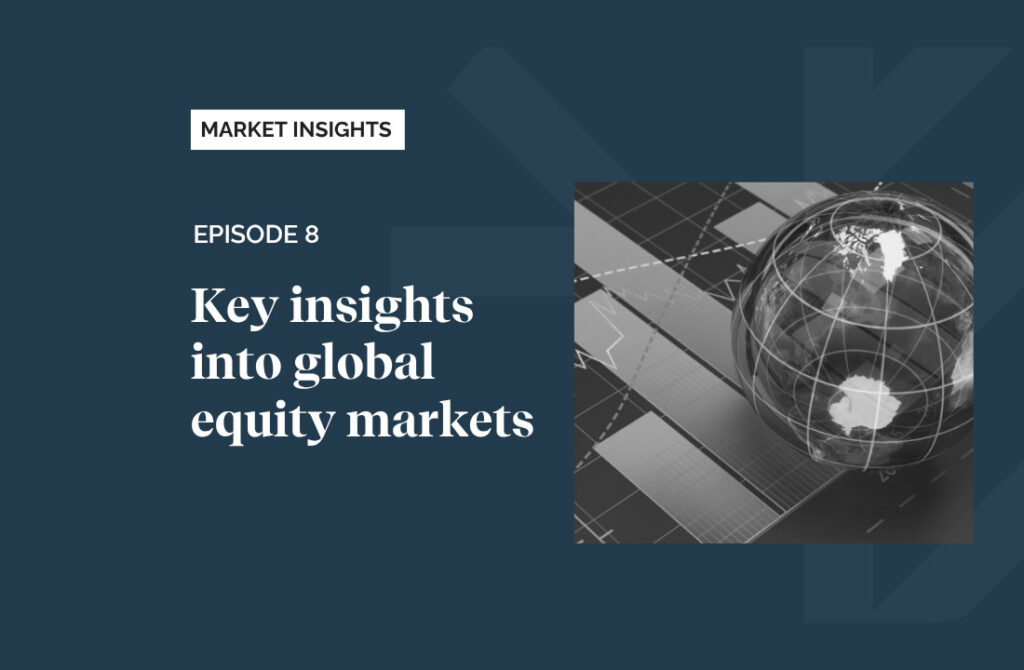Gold has long been considered a safe haven asset, especially during periods of economic uncertainty. This is because gold is tangible, anticorrosive and a store of value, unlike modern-day fiat currency. As of April 2025, gold prices have surged, approaching record highs. Traditional correlations such as US real rates and the dollar have somewhat broken down, so what is currently supporting the yellow metal?
Graph 1: Traditional relationships have softened somewhat

Factors supporting gold prices
Geopolitical tensions and economic policy uncertainty
Recent geopolitical developments have significantly influenced gold prices. In April 2025, trade tensions between the US and China escalated and remain fluid. This move intensified market volatility and led investors to seek refuge in safe-haven assets, including gold. Economic challenges, including concerns over inflation and slow global growth, have bolstered gold’s appeal. In April 2025, gold surged toward record highs amid fears of economic instability following US tariff hikes and geopolitical tensions. Gold’s status as a hedge against inflation and economic uncertainty continues to support its demand.
Graph 2: Global policy uncertainty index & gold. Trade war = Higher gold

Central bank purchases
After Russia invaded Ukraine and Russia was cut off from the global monetary system, other central banks, most pronounced across emerging markets, have been significant buyers of gold, contributing to its price appreciation. In 2024, China’s central bank resumed purchases, adding five tonnes to its reserves, bringing total holdings to 2,264 tonnes. Such purchases by emerging market central banks have been a fundamental driver of the gold rally since 2022.
Graph 3: Central banks have increased their gold-buying

Monetary policy and interest rate cuts
Monetary policies, particularly interest rate decisions, play a crucial role in gold’s performance. In September 2024, the US Federal Reserve initiated a rate-cut cycle with a 50-basis-point reduction. Lower interest rates make traditional fixed-income investments less attractive, leading investors to gold, which does not yield interest but offers potential for price appreciation. A key investment debate when considering exposure to gold is whether to hold the gold metal through an ETF or rather buy the gold equities; both have merits and drawbacks.
Merits owning gold equity shares
Leverage to gold prices
Gold equity shares, representing ownership in gold mining companies, often provide leveraged exposure to gold prices. When gold prices rise, the revenues and profits of mining companies typically increase, potentially leading to higher stock prices. For instance, in early 2025, gold stocks like Newmont and Barrick Gold saw share price increases of 29% and 21%, respectively, as gold prices surged.
Dividend income
Many gold mining companies offer dividends to shareholders, providing a source of income. The dividend yields can be attractive, especially when gold prices are high, enhancing the overall return on investment.
Risks of owning gold equity shares
Operational and management risks
Gold mining companies face operational challenges, including mining accidents, labour disputes, and poor management decisions. Operational inefficiencies or poor capital allocation decisions can adversely affect a company’s profitability and, consequently, its stock price. The profitability of gold mining companies is influenced by their cost structures. Rising operational costs, such as energy and labour, can squeeze margins, especially if gold prices do not increase correspondingly. This margin squeeze usually results when inflation is high and increases the per-ounce cost structure of a gold company. Capex is also a key consideration as mining operations are very capital-intensive and strategic decisions to invest or buy an operation can often be done at the top of the commodity cycle.
Regulatory and environmental risks
Mining operations are subject to stringent regulations and environmental considerations. Changes in regulations, environmental policies, or failure to comply with legal standards can result in fines, operational delays, or increased costs, impacting shareholder value.
Geopolitical and country risks
Mining companies operating in politically unstable or high-risk regions face additional challenges. Expropriation risks, political unrest, and adverse changes in local laws, including royalties and corporate tax, can disrupt operations and negatively affect stock performance.
Conclusion
Closing thoughts
Gold prices are currently supported by a combination of geopolitical tensions, robust central bank purchases, accommodative monetary policies, and prevailing economic uncertainties. Investing in gold equity shares offers potential benefits, including leveraged exposure to gold prices, dividend income, and participation in company growth. However, investors must also be mindful of the inherent risks associated with mining operations, cost fluctuations, regulatory changes, and geopolitical factors. A thorough assessment of these factors is essential for making informed investment decisions in the gold equity sector.
Topics
We are Fairtree
Subscribe to our newsletter
Stay informed with the latest insights and updates. Subscribe to our newsletter for expert analysis, market trends, and investment strategies delivered straight to your inbox.
"*" indicates required fields

FAIRTREE INSIGHTS
You may also be interested in
Explore more commentaries from our thought leaders, offering in-depth analysis, market trends and expert analysis.

Macro Pulse Episode 21
In this episode Jacobus discusses SA equities, SA bonds and the appreciating of the US dollar.

Fairtree Market Insights with Karena Naidu | Episode 8
In this episode, we dive into our Chinese exposure, exploring what’s happening with the major e-commerce players in China. We also take a closer look at the broader emerging markets space, unpacking key trends and where we’re seeing potential growth.

Macro Pulse Episode 20
In this episode, Jacobus discusses major events leading up to year-end, recent US court cases, and the rise in long bond yields.
About you…
By proceeding, I confirm that:
- To the best of my knowledge, and after making all necessary inquiries, I am permitted under the laws of my country of residence to access this site and the information it contains; and
- I have read, understood, and agree to be bound by the Terms and Conditions of Use described below.
- Please beware of fraudulent Whatsapp groups pretending to be affiliated with Fairtree or Fairtree staff members.
If you do not meet these requirements, or are unsure whether you do, please click “Decline” and do not continue.




